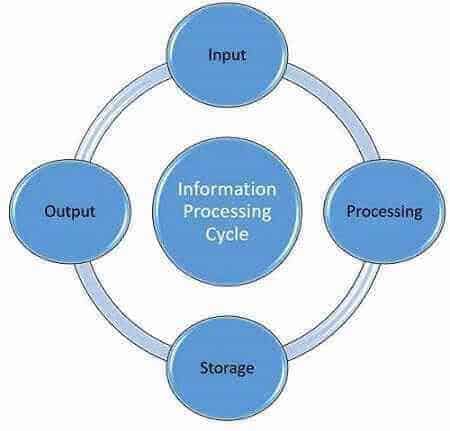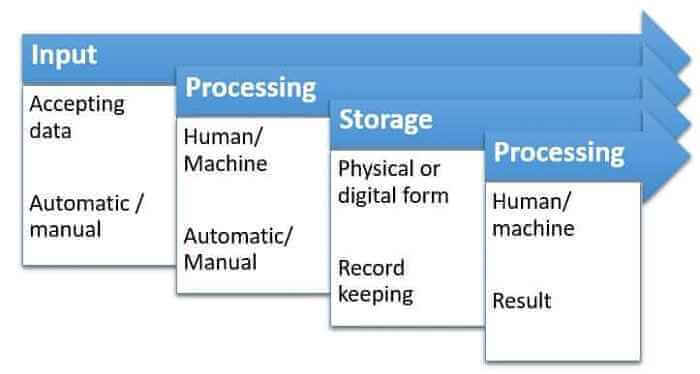What is information processing?
Information processing is the process of changing or converting information into meaningful form. Information is a processed, organized or classified data which is useful for the receiver. Information is the processed data which may be used “as is” or may be put to use along with more data or information. The receiver of information takes actions and decisions based on the information received. Collected data must be processed to get meaning out of it, and this meaning is obtained in the form of information. Further information is considered useful & meaningful only if has these characteristics
- Timely − Information should be available when required, a delay in obtaining information renders it useless.
- Accuracy − Accuracy of information has a significant impact on the decision-making. Possibilities of even slightest errors should be minimized
- Completeness − Information should be complete. Incomplete information causes incorrect and unintended results.
- Comprehensive – Information which is incomprehensible is useless for the receiver. This becomes a case of information failure as the sender sent the information, but it was of no use for the receiver, thus is not considered as “information.”
Understanding “information processing” in daily life and Examples
Information is the processed data which is of some use for humans. Information may further be processed and/or manipulated to form knowledge. Information containing wisdom is known as knowledge. Taking an example of information processing, digits in a report card are considered as information; similarly, stats, when placed in a report or used in some context, provides an understanding. Data collected during surveys is meaningless unless it is processed. Good questionnaires are formed and surveys are conducted to collect data which can be processed to give useful insight. Another example can be a tabular data if merely a table is constructed without with the available data it might not convey the intended message, but when data mapping is done using that data to create graphs & charts, it becomes information. Thus information processing is important.
Understanding Information processing Cycle
Information processing cycle is a sequence of events consisting of input, processing, storage & output. To understand more about what is information processing cycle it is a good idea to study about data processing cycle also. These events are similar as in case of data processing cycle. For a computer to perform useful work, the computer has to receive instructions and data from the outside world. The computer receives data and instructions during the INPUT stage of the information processing cycle. Useful information results when appropriate instructions are applied to data. Applying instructions to data takes place during the PROCESSING stage of the information processing cycle. To avoid having to re-enter data and instructions or reprocess information, computers can save information. Saving information on a computer occurs during the STORAGE phase of the information processing cycle. Saving information on a computer occurs during the Storage phase of the information processing cycle. This is followed by the result in the OUTPUT stage. Computer Processing Cycle is a similar process with similar steps by which data is fed to a computer.

Four phases of the of the cycle to process information
1. Input: Computer receives data and instructions
2. Process: Computer applies instructions to data to produce information (organized Data)
3. Storage: Saving the information for a subsequent use or use in future
4. Output: Computer sends information to people in a usable format.
Related: Data Processing, Data Processing Methods, Data Mining

- Input – Entering data into the computer
- Feeding the collected raw data in the cycle for processing. This is the raw data which is supplied for processing & obtaining information.
- Input can be done by utilizing various devices such as keyboards, mice, flatbed scanners, barcode readers, joysticks, digital data tablets (for graphics drawing), electronic cash registers, etc
- Processing – Performing operations on the data
- Once the input is provided the raw data is processed by a suitable or selected processing method. This is the most crucial step as it allows for the processed data in the form of output which will be used further.
- Processing is usually done by CPU (Central Processing Unit) in a computer. CPU is the crucial component for getting the operations done.
- Storage – Saving data in a soft/physical form
- This is the outcome, and the raw data provided in the first stage is now “processed,” and the data is useful and provides information and no longer called data.
- Storage can be done on external hard disk, inbuilt hard disk, pen drives, micro SD cards, compact disks or even in registers.
- Output – Results obtained, i.e., information
- This is the outcome, and the raw data provided in the first stage is now “processed,” and the data is useful and provides information and no longer called data. This might be further used for data visualisation.
- This can be used as it is or used for further processing along with more data.
Role of Data Processing in Information processing
Data processing is an essential part of information processing. Making use of processed information in various decision making process remains the main purpose of information processing. Processing of complex data obtained from various data sources requires sorting and filtering of data. It might also be merged with existing sources of data so as go to receive a new data set. Further analysis of these data sets helps in decision making and subsequent decisions pertaining to other aspects in a decision making process. The information being used may form a part of short term memory or long term memory of overall process.
Tags: Information Processing, Information Processing Cycle, Information Cycle, Processing Cycle, Four stages of information processing, data processing cycle, computer processing cycle, stages of information processing, stages of processing
Read about: Data presentation & analysis, Data Management Best practices, Data Visualization, What is Information Processing Theory?
It’s great info provided
Very helpful and straight to the main points thanks .
I want devices which can be used in replacement of the stages of processing cycle
Please I would have also wanted some importance of INFORMATION PROCESSING CYCLE IN BASIC SCHOOLS